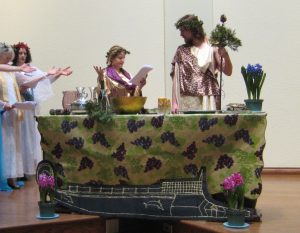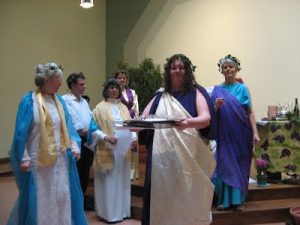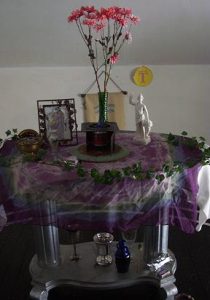by Jessi and Melissa

(11-13 Anthesterion) A three-day festival that literally means Festival of Flowers, it celebrates the Spring and new wine and honors or pacifies the dead. At the beginning of the holiday, the Athenians would crown children who were three years old with wreaths of the first flowers of the year. The first day, Pithoigia (Opening the Jars), focused on opening new jars of wine, pouring libations to Dionysos and praying that partaking of the wine, mixed with water as the God had taught, should be beneficial and harmless, and then drinking. Children often received their own small pots of wine. The second day, Khoes (Day of Cups), was filled with drinking contests and an erotic mood. Khoes ended with the sacred marriage of Dionysos and the queen. This occurred in the (usually closed except this night) inner chamber of the temple of Dionysos in the Marshes, and the details were kept secret. Khytrai (The day of Pots) was the last day and was devoted to the cult of the dead. Pots containing the traditional foods for the dead, cooked grains and seeds (today called koliva), were left out for the spirits of ancestors. Despite leaving food for the dead, people took precautions against the dead coming too close. These precautions included chewing buckthorn, roping off temples and smearing house doors with pitch. At the end of the festival, citizens would shout “Through the doors, Kares, it’s no longer Anthesteria!” and all would return to normal (Parke, pp. 106-120).

Ways to celebrate in modern times: Try to celebrate this over a three-day weekend (US worshipers have with President’s Day falling near this time) or beginning from Friday afternoon through Sunday. Supply plenty of sweet wine (watered-down as the ancients did, with 3 parts water to 1 part wine) as well as plenty of non-alcoholic beverages for drinking and libation. Also provide designated drivers or places to sleep for participants that do choose to drink. Since ancient Athenians brought their own food and wine to the feast, this is an occasion for pot luck, the host providing desserts only. Decorate the ritual area or your home with flowers (especially on the first day), bare branches from which masks and figurines dangle (second day), pots filled with koliva (third day only) and images of Dionysos (but not phallic images this time). Recite Orphic Hymns 30 and 45, Homeric Hymns I, VII and XXVI (all to Dionysos), or even hymns and poems of your own creation.

Sample ritual scripts are also available here.
Parke, H.W., Festivals of the Athenians, 1977
